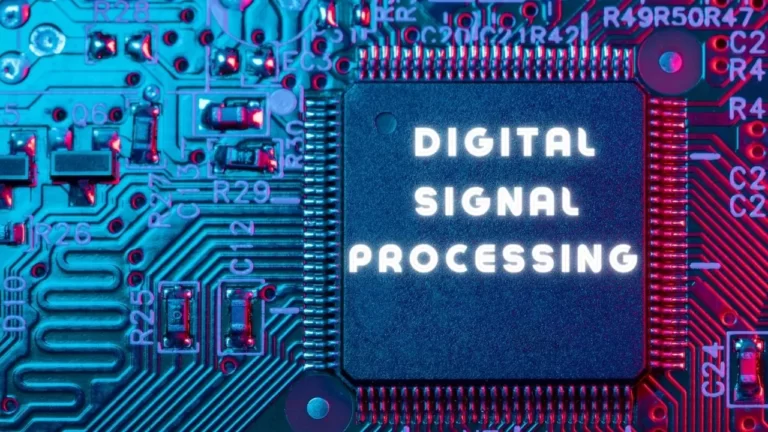Introduction
Imagine a video conference where everyone’s voices seem to be in the same room, or a live performance where every note is perfectly clear. How is this degree of accuracy attained? Digital Signal Processing in AV systems, an unsung hero that improves audio-visual experiences in real time, holds the key to the solution. Digital Signal Processing (DSP) is essential to contemporary AV systems for anything from intelligent signal correction to echo cancellation and noise reduction. This essay will explain the foundations of DSP, examine practical uses, and demonstrate how it transforms audio and visual technologies.
Fundamentals of Digital Signal Processing in AV Systems
Fundamentally, digital signal processing (DSP) uses specialized hardware DSP chips or software algorithms to modify audio and visual inputs. This procedure entails:
- Digitally converting analog signals (like video feeds or microphone input).
- Making adjustments in real time, including compression, equalization, and filtering.
- Returning processed signals to analog for use with display panels or speakers.
This guarantees a flawless experience by enabling AV system integration to dynamically enhance audio and video quality.
Key Advantages of DSP in AV Systems
- Noise reduction: Enhances sound quality by eliminating background noise.
- Signal correction modifies dynamic range, compression, and frequencies.
- During live calls, echo cancellation removes acoustic echo.
- Consistent audio levels are maintained by automatic gain control.
- Real-time video processing improves image stabilization, color correction, and sharpness.
- Efficiency & Reliability: Increases longevity and lowers hardware requirements.
Without the need for human involvement, DSP guarantees that every AV stream is adjusted in real-time, delivering high-definition sound and images.
Key Features of DSP in AV Systems
DSP provides a number of sophisticated capabilities that significantly improve AV systems’ audio and video performance.
Noise Reduction and Suppression
The ability of DSP to eliminate unwanted noise is one of its greatest benefits.
- DSP algorithms suppress hisses, hums, and crowd noise by effectively distinguishing between speech and background sound.
- Conference room DSPs improve voice clarity by removing keyboard clatter and air conditioning noise.
DSP noise reduction can increase voice clarity by up to 25 dB, according to studies, greatly improving intelligibility.
Acoustic Echo Cancellation (AEC)
Voice calls with echo can be annoying. By identifying and eliminating echoes in real time, DSP gets rid of this.
- Delayed sound is dynamically subtracted from microphone inputs by AEC.
- Vital for online meetings, live events, and conference calls.
Audio visual solutions powered by AEC-based DSP make high-quality full-duplex conversations—where both sides talk at the same time, practically possible.
Automatic Gain Control (AGC) & Leveling
It might be challenging to maintain a consistent listening experience because people naturally speak at different volumes.
- AGC actively adjusts audio levels in real time to maintain consistent sound quality.
- prevents abrupt volume spikes by reducing loud speaking and enhancing quiet voices.
- Vital for public address systems, live streaming, and meeting spaces.
Equalization and Tone Correction
Environments and spaces have an impact on how sound is heard. To provide the best audio quality, DSP enables accurate equalization:
- Eliminates too much bass in cramped spaces.
- For clarity, the treble and midrange frequencies are balanced.
- Optimizes performance by automatically adjusting the sound in home theater systems.
- For digital signage, DSP enhances video by applying real-time color correction, sharpening, and gamma adjustments.
DSP ensures high-definition visual clarity for video by applying real-time color correction, sharpening, and gamma changes.
Audio & Video Signal Routing and Mixing
Contemporary AV systems use a variety of input sources, including media players, cameras, and microphones.
-
DSP enables intelligent signal routing, allowing users to manage multiple sources with ease.
-
Engineers use live audio mixing to deliver a balanced output for broadcasts, meetings, or concerts.
- adaptive processing, like video stream lip-synch correction.
DSP is therefore revolutionary for live events, broadcasting, and smart home automation.
How DSP Transforms Modern AV Experiences
DSP technology is transforming the way we perceive sound and images in everyday situations. Here’s how:
Live Events and Concerts
It might be difficult to guarantee consistent sound throughout a performance venue. Enabled audio systems with DSP:
- Adapt speaker delays automatically to ensure uniform coverage.
- If you want to avoid microphone feedback, use noise cancellation.
- Improve live mixing to create a clear, captivating experience.
Without DSP, live audio often suffers from feedback loops, distortion, and uneven sound levels.
Conference Rooms & Video Calls
Clear communication is crucial in meetings. AV integrators leverage DSP-powered conference room speakerphones to:
- Removing background noise from fans, typing, and air conditioning.
- Ensuring that each participant’s volume is constant (AGC).
- Synchronizing audio and video to achieve precise lip-synch.
Home Theaters & Smart AV Systems
DSP-based audio processors are used by home entertainment systems to:
- Decode DTS and Dolby Atmos surround sound for rich 3D audio.
- Adapt sound automatically to the acoustics of the room.
- Video resolution upscaling (converting 1080p to 4K, for example).
As a result, you may enjoy movie-quality sounds and pictures from the comfort of your own home.
Public Address & Multi-Zone Audio
In stadiums, shopping centers, and airports, DSP guarantees:
- Announcements that are loud and clear, even in noisy settings.
- automatically adjusting the volume according to the amount of background noise.
- Audio control for specific zones for focused messaging.
DSP optimizes clarity and intelligibility in stadiums and commercial malls.
The Future of DSP in AV Systems
DSP will get even smarter as technology advances.
- AI-powered DSP will automate real-time speech improvement.
- Three-dimensional spatial audio processing will enhance VR and AR experiences.
- Machine learning techniques will dynamically adjust DSP settings based on various circumstances.
With advancements in automation and AI, DSP will continue redefining AV solutions, providing even more immersive and seamless user experiences.
Conclusion
Today’s AV technology is built on digital signal processing. Superior audio and visual performance is provided by DSP, which offers AI-driven improvements as well as noise reduction and echo cancellation.
DSP guarantees flawless, real-time signal optimization, enhancing the smoothness and immersion of any AV experience, whether in home theaters, conference spaces, or concerts.
Are you prepared to use DSP to enhance your AV experience? For professional advice on selecting the best DSP-enabled antivirus software, get in touch with us.





